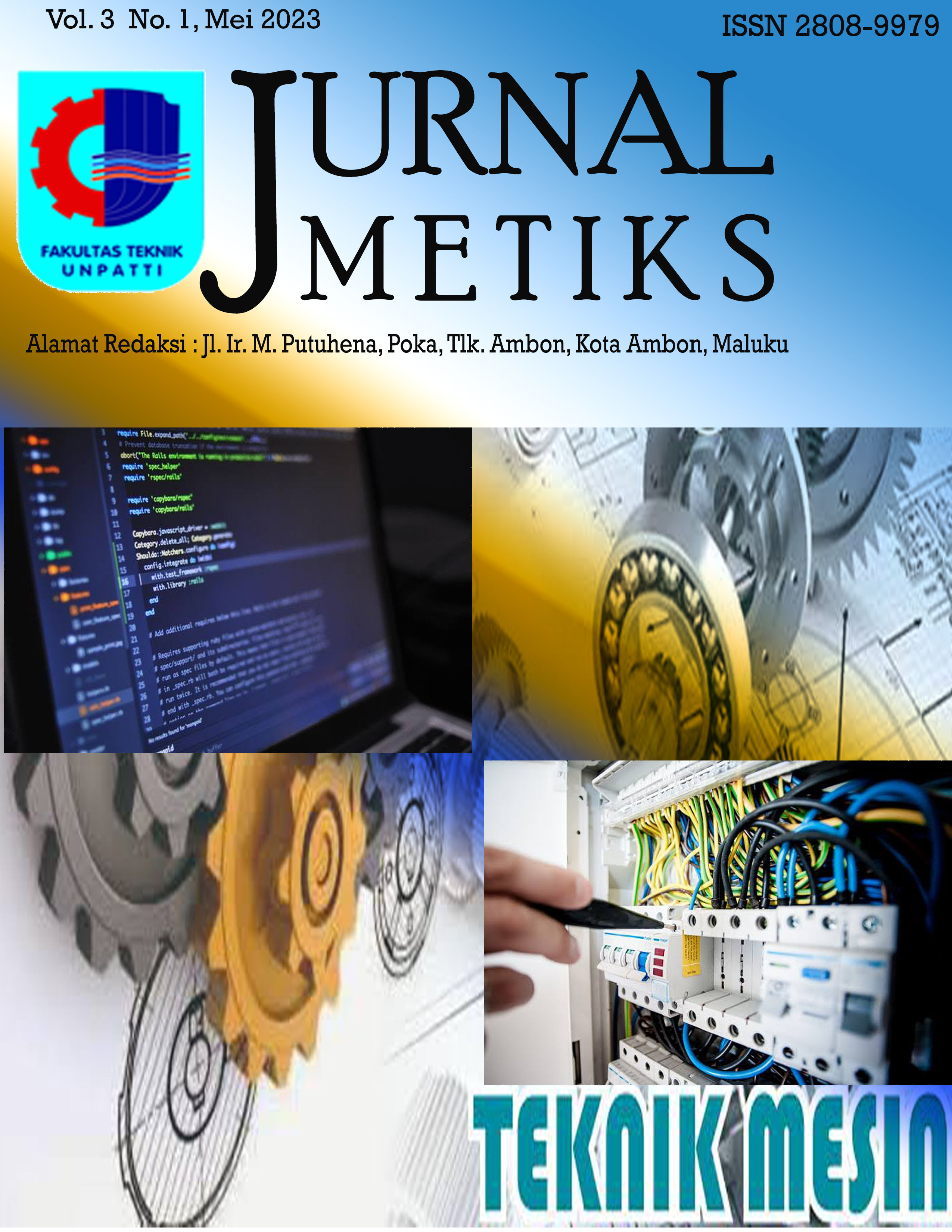EVALUASI KINERJA POMPA SENTRIFUGAL BERKAPASITAS 600 KL/Hr PADA SISTEM PEMOMPAAN MINYAK
Abstract
Pompa sentrifugal adalah pompa dengan efisiensi tinggi, konstruksi sederhana dan banyak digunakan di dunia. Pompa sentrifugal modern saat ini beroperasi dengan efesiensi lebih dari 70% pada berbagai nilai putaran. Namun kesesuaian kerja dengan sistem pemompaan merupakan masalah penting dalam engineering dimana pompa harus dipilih sesuai kebutuhan sistem sehingga dapat bekerja dengan baik dan effisien. Pemilihan dan pengoperasian pompa untuk aplikasi didasarkan pada kurva karakteristik yaitu hubungan antara head (H), daya (P) dan efesiensi (η) terhadap debit (Q) dan kesesuaiannya dengan system pemompaan. Berapakah nilai optimal kinerja pompa dan sistemnya merupakan masalah utama riset ini yang harus diselesaikan dengan tujuan menentukan kondisi optimal kerja pompa dan sistem pemompaan. Analisis dilakukan secara teoritis dan membandingkan hasilnya dengan data lapangan yang tersedia. Secara teoritis pompa kondisi optimum dimana parameter-parameter operasi berada pada nilai efesiensi pompa maksimum yaitu 70%, dimana head optimum pompa berada pada nilai Q/Qd =1,28 atau pada nilai debit Q = 0,054 m3/s, daya yang diberikan oleh pompa pada titik ini mencapai maksimum. Karena hasil perhitungan head pompa menunjukan hasil yang hampir mendekati nilai head aktual hasil pengamatan, sehingga dapat disimpulkan bahwa hasil perhitungan teoritis dapat digunakan sebagai pertimbangan dalam perencanaan dan operasi sistem pemompaan.
Downloads
References
K. E. Kurniawan, B. Santoso, and D. D. D. P. Tjahjana, “Improvement of centrifugal pump performance through addition of splitter blades on impeller pump,” AIP Conf. Proc., vol. 1931, no. February 2018, pp. 1–6, 2018, doi: 10.1063/1.5024112.
W. Sanchez Ocana, C. Carvajal, J. Poalacan, M. I. Pazmino, E. S. Jacome, and L. Basantes, “Cavitation Analysis with CFD Techniques of the Impeller of a Centrifugal Pump,” Indian J. Sci. Technol., vol. 11, no. 22, pp. 1–6, 2018, doi: 10.17485/ijst/2018/v11i20/123055.
S. Linn, “Operating Principle of Centrifugal Pump and its Applications,” J. Appl. Mech. Eng., vol. 11, no. 1000424, p. 1000424, 2022, doi: 10.35248/2168-9873.22.11.424.Citation.
K. Alawadhi, B. Alzuwayer, T. A. Mohammad, and M. H. Buhemdi, “Design and optimization of a centrifugal pump for slurry transport using the response surface method,” Machines, vol. 9, no. 3, 2021, doi: 10.3390/machines9030060.
P. Piyushkumar, S. Valand, and R. Suthar, “A Technical Review on Analysis of Centrifugal Pump,” Int. J. Sci. Res. Sci. Technol. IJSRST, vol. 4, no. 5, pp. 785–790, 2018.
R. Torabi and S. A. Nourbakhsh, “The effect of viscosity on performance of a low specific speed centrifugal pump,” Int. J. Rotating Mach., vol. 2016, 2016, doi: 10.1155/2016/3878357.
W. Yin, “CFD SIMULATION OF THE INFLUENCE OF VISCOSITY ON AN,” Texas A&M University, 2016.
P. Liu et al., “Effects of fluid viscosity and two-phase flow on performance of ESP,” Energies, vol. 13, no. 20, 2020, doi: 10.3390/en13205486.
B. Kim, M. H. Siddique, A. Samad, G. Hu, and D. E. Lee, “Optimization of Centrifugal Pump Impeller for Pumping Viscous Fluids Using Direct Design Optimization Technique,” Machines, vol. 10, no. 9, pp. 1–26, 2022, doi: 10.3390/machines10090774.
X. Li, Z. Zhu, Y. Li, and X. Chen, “Experimental and numerical investigations of head-flow curve instability of a single-stage centrifugal pump with volute casing,” Proc. Inst. Mech. Eng. Part A J. Power Energy, vol. 230, no. 7, pp. 633–647, 2016, doi: 10.1177/0957650916663326.
Q. Si, G. Bois, Q. Jiang, W. He, A. Ali, and S. Yuan, “Investigation on the handling ability of centrifugal pumps under air-water two-phase inflow: Model and experimental validation,” Energies, vol. 11, no. 11, pp. 1–17, 2018, doi: 10.3390/en11113048.
M. Hassan Gobran, “Numerical Simulation of Centrifugal Pump and Effect of Impeller Geometry on Its Performance,” Eng. Appl. Sci., vol. 4, no. 2, p. 21, 2019, doi: 10.11648/j.eas.20190402.11.
A. Ayad, H. Abdalla, and A. Abo El-Azm, “Numerical Study of the Semi-Open Centrifugal Pump Impeller Side Clearance,” Int. Conf. Aerosp. Sci. Aviat. Technol., vol. 16, no. AEROSPACE SCIENCES, pp. 1–14, 2015, doi: 10.21608/asat.2015.23015.
M. E. Matlakala and D. V. von Kallon, “Optimization of the Pumping Capacity of Centrifugal Pumps Based on System Analysis,” 12th South African Conf. Comput. Appl. Mech. SACAM 2020, vol. 00024, 2020, doi: 10.1051/matecconf/202134700024.
R. A. Rivaldy and D. Mulyono, “Optimalisasi Unjuk Kerja Pompa Sentrifugal P1302 di PT Petrokimia Gresik,” Pros. Semin. Nas. Teknol. Energi dan Miner., vol. 2, no. 1, pp. 300–308, 2022, doi: 10.53026/sntem.v2i1.853.
C. B. Jacobsen, The Centrifugal Pump, Grundfos. GRUNDFOS Management, 2010.
W. M. Rumaherang, J. Louhenapessy, M. F. Noya, and C. S. Tupamahu, “Studi Eksperimental Performance Kavitasi Waterjet Propulsi,” ALE Proceeding, vol. 4, pp. 112–120, 2021, doi: 10.30598/ale.4.2021.112-120.
W. M. Rumaherang, “Perhitungan aliran dan peramalan karakteristik pompa sentrifugal bertingkat dengan penggunaan CAD blade’s system,” J. Ilm. Tek. Mesin CAKRAM, vol. 2, no. 2, pp. 69–76, 2008.
A. Nasution, M. Nasution, and M. Rohim, “Analisa Pengaruh Sudut Masuk Terhadap Jumlah Sudu Pada Sudu Pompa Sentrifugal,” Piston, vol. 4, no. 2, pp. 51–58, 2020, [Online]. Available: http://repository.uisu.ac.id/handle/123456789/410
L. Gevorkov, “Model Based Power Estimation for Centrifugal Pumps,” in Conference Paper ·, 2017, no. January, pp. 1–5. [Online]. Available: https://www.researchgate.net/publication/313249514%0AModel
S. Amrullah, R. Jayana, G. Fadhilah, and A. D. Puspita, “Perbandingan Kualitas Minyak Pirolisis, Minyak Tanah, dan Solar The Quality Comparison of Pirolysis Oil, Kerosene, and Diesel,” J. Pengendali. Pencemaran Lingkung., vol. 3, no. 02, pp. 51–57, 2021, [Online]. Available: https://ejournal.pnc.ac.id/index.php/jppl
W. T. Putra, M. Malyadi, and A. Bima, “Studi Ekperimen Campuran Bahan Bakar Minyak Plastik jenis PET dengan Premium dan Pertamax,” in Prosiding SNTTM XVIII, 9-10 Oktober 2019, KE24, 2019, pp. 9–10.
Pertamina, “Spesifikasi Produk BBM, BBN & LPG,” Spesifikasi Prod. BBM, BBN LPG, p. 23, 2020.
W. G. Li, “Modeling Viscous Oil Cavitating Flow in a Centrifugal Pump,” J. Fluids Eng. Trans. ASME, vol. 138, no. 1, 2016, doi: 10.1115/1.4031061.
W. Nuha, W. M. Rumaherang, and J. Louhenapessy, “Optimasi Parameter-Parameter Energi Pada Clutch Point Konverter Torsi Melalui Variasi Rasio Putaran,” J. Tek. Mesin, Elektro, Inform. Kelaut. dan Sains, vol. 1, no. 1, pp. 23–29, 2021, doi: 10.30598/metiks.2021.1.1.23-29.
H. I. Kim, T. S. Roh, H. Huh, and H. J. Lee, “Development of Ultra-Low Specific Speed Centrifugal Pumps Design Method for Small Liquid Rocket Engines,” Aerospace, vol. 9, no. 9, pp. 1–19, 2022, doi: 10.3390/aerospace9090477.
A. S. Aidhen, S. Malik, and C. D. Kishanrao, “Turbine mode performance evaluation of centrifugal pump,” Int. J. Eng. Adv. Technol., vol. 9, no. 1, pp. 6804–6809, 2019, doi: 10.35940/ijeat.A2980.109119.
Merkley and Allen, “Pumps & System curves,” Sprink. Trickle Irrig. Lect., vol. 123, no. 226, pp. 123–144.
A. W. C. C. Makes, Pump Principles. CHESTERTON. [Online]. Available: http://powerequipment.honda.com/pumps/pump-theory-1
A. Patil and G. Morrison, “Affinity law modified to predict the pump head performance for different viscosities using the morrison number,” J. Fluids Eng. Trans. ASME, vol. 141, no. 2, 2019, doi: 10.1115/1.4041066.
M. M. Shamsuddeen et al., “Flow field analysis and feasibility study of a multistage centrifugal pump designed for low-viscous fluids,” Appl. Sci., vol. 11, no. 3, pp. 1–16, 2021, doi: 10.3390/app11031314.
M. A. El-Naggar, “A one-dimensional flow analysis for the prediction of centrifugal pump performance characteristics,” Int. J. Rotating Mach., vol. 2013, no. 1, 2013, doi: 10.1155/2013/473512.
K. A. Flack and M. P. Schultz, “Roughness effects on wall-bounded turbulent flows,” Phys. Fluids, vol. 26, no. 10, 2014, doi: 10.1063/1.4896280.
A. A. Madeira, “Major and minor head losses in a hydraulic flow circuit: Experimental measurements and a Moody’s diagram application,” Eclet. Quim., vol. 45, no. 3, pp. 47–56, 2020, doi: 10.26850/1678-4618eqj.v45.3.2020.p47-56.
F. Ansori and E. Widodo, “Analysis on Centrifugal Pump Performance in Single, Serial, and Parallel,” J. Energy, Mech. Mater. Manuf. Eng., vol. 3, no. 2, p. 79, 2018, doi: 10.22219/jemmme.v3i2.6958.
D. Bach, F. Schmich, T. Masselter, and T. Speck, “A review of selected pumping systems in nature and engineering - Potential biomimetic concepts for improving displacement pumps and pulsation damping,” Bioinspiration and Biomimetics, vol. 10, no. 5, 2015, doi: 10.1088/1748-3190/10/5/051001.
L. Cao, Y. Zhang, Z. Wang, Y. Xiao, and R. Liu, “Effect of Axial Clearance on the Efficiency of a Shrouded Centrifugal Pump,” J. Fluids Eng. Trans. ASME, vol. 137, no. 7, 2015, doi: 10.1115/1.4029761.
W. Li, L. Ji, W. Shi, L. Zhou, H. Chang, and R. K. Agarwal, “Expansion of High E ffi ciency Region of Wind Energy,” J. Energies, vol. 13, no. 2, pp. 1–24, 2020.
M. S. de la Fuente, J. González, C. M. González, R. B. Perotti, and E. Reynaud, “NPSH Experimental Data for Two Centrifugal Pumps,” in MDPI, 2018, no. 1, p. 1410. doi: 10.3390/proceedings2231410.
H. Zhu, G. Bo, Y. Zhou, R. Zhang, and J. Cheng, “Performance prediction of pump and pumping system based on combination of numerical simulation and non-full passage model test,” J. Brazilian Soc. Mech. Sci. Eng., vol. 41, no. 9, pp. 1–12, 2019, doi: 10.1007/s40430-019-1874-9.
Copyright (c) 2023 Journal Teknik Mesin, Elektro, Informatika, Kelautan dan Sains

This work is licensed under a Creative Commons Attribution-NonCommercial 4.0 International License.








